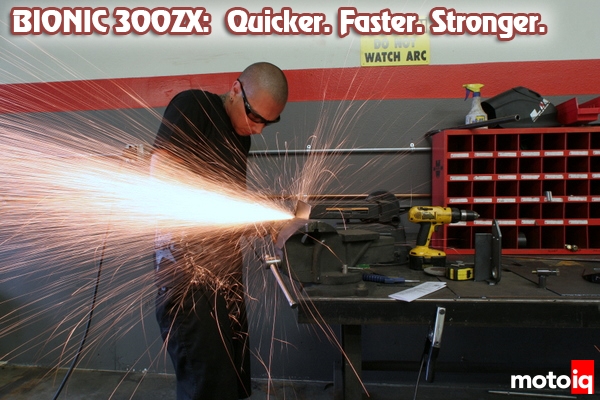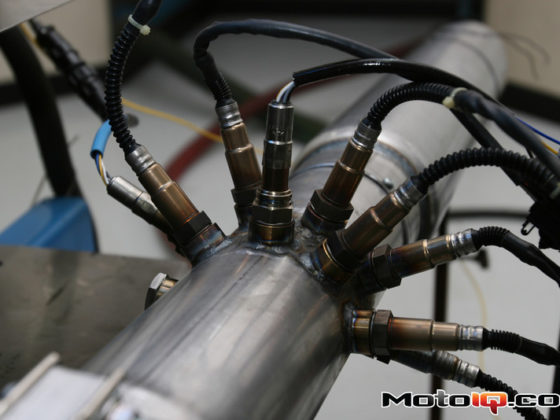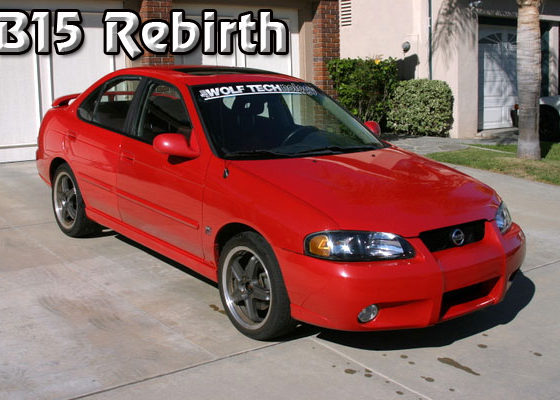,
Louie’s craftsmanship is amazing! He first fits the tubes as tight as possible to the perimeter of the unibody, then welds them together in sequence. He sometimes cuts a hole in the floor of the car so the cage can be lowered allowing him to weld completely around the tube in all locations. Believe it or not, many cage builders don’t do this and you lose a lot of strength with partial welds.
 |
| Proper mitering is important in TIG welding. The gaps between tubes must be tight so a small electrode can be used to keep the heat affected zone of the weld small. The mitered joints are first cut with a hole saw using this jig to get the angle right |
 |
| A belt sander, die grinders and an apex grinder are used to do the final fitting keeping the gaps small and tight. |
 |
| The mitered tubes are first tack welded as the cage starts to come together. |
All of his weds are TIG. TIG stands for Tungsten electrode, Inert Gas. In TIG welding, the welding arc is shielded by argon or some other inert gas. A handheld electric arc torch with a tungsten electrode, creates enough heat to melt the base metal and a filler rod is fed in by hand to complete the bead. The argon shield prevents the weld from picking up oxidation from the air which weakens the weld. Because the welder can control the welds size and depth, by varying the current with a foot pedal and technique, TIG welding has a minimal heat affected zone. A good welder can create the beautiful smooth and even weld beads that TIG welding is famous for. TIG welding is the strongest type of normal welding that can be done.
TIG’s drawbacks are that it's slower, requires more precise mitering of the tubes beforehand and requires more skill and experience to do vs. the faster and cheaper MIG welding that most cage builder use.
 |
| Like all good fabricators, Louie meets with us during major milestones in the cages construction to ensure that we are satisfied with the work and everything is to spec. |
 |
| To be able to ensure that all welds go 360 degrees around every tube, Louie cuts a small hole in the floor so the tacked together cage can be lowered to give the welding torch full access around every tube. Many cage builders skip this step and many cages I have seen don’t have proper welds. If a tech inspector sees this sort of stuff, your cage may fail tech. |
 |
| After the top tubes are welded, Louie taps the floor plate in place to seal up the hole and welds that to the chassis. What a cool trick! |
 |
| The floor plates are contoured to the floor for a tight fit with a dead blow mallet. |
 |
| Then they are TIG welded to the chassis. |
For a cage to be strong, it helps if the cage is coupled to the unibody in as many places as possible. By tying the cage to the chassis, bending loads or severe impacts are spread thoughout the whole structure of the car, not just the cage and the body independently. If done correctly, adding dimple die reinforcing plates can double the overall strength of the structure with little added weight. Louie did this by complexly tying the main tubes into the body structure with formed dimple die cut plates. Thin 0.090″ thick steel was used. Dimple dies are used to make holes in the plates to lighten them. The flanges formed by the dimpled holes also stiffen the plates. The plates were TIG welded to the cage and the unibody using a silicon bronze filler rod. Silicon Bronze allows more flex between the cage and body reducing the likelihood of crack formation.
 |
| There is a reason why welders wear masks with dark shades! |
 |
| For the front tube mounts Louie constructs a box that he welds to the frame rails as well as the floor. This spreads out the load over a wide area of the chassis and is far superior to your typical simple plates welded to the floor. |
 |
| The finished mount is very sturdy |
 |
| An upper X forms a strong halo of steel above the driver |
 |
| The “A” pillar is a prime place to tie the cage into the unibody to help stiffen things up |
 |
| A dimple die plate starts with a piece of thin 0.090 steel sheet. This means that the plates are very light. They may be light but they contribute a lot to the chassis overall strength. |
 |
| A template for the plate is first made out of cardboard and transferred onto the metal, then the part is cut out using a plasma cutter. |
 |
| After plasma cutting the plate is cleaned up and fitted with an angle grinder |
 |
| The finished plated is skip welded to the cage and body using a silicon bronze filler rod. This gives the joint more flexibility and reduces the likelihood of cracking |
 |
| Both “A” pillars are given the treatment |
Related




1 comment
Pics not working 🙁